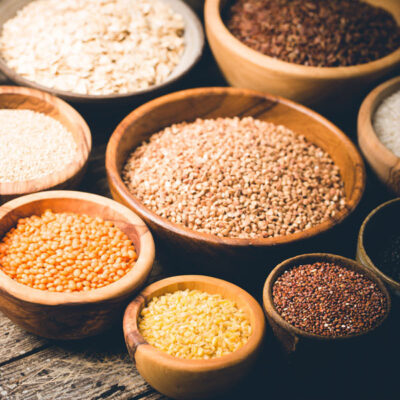Brands
Is There Gluten in Potatoes?
By: admin On: 12 July 2024

What about Gluten in potatoes? The answer to the question 'Is there gluten in potatoes' may be more complex than you think.
The answer to the question 'Is there gluten in potatoes' may be more complex than you think. A potato itself does not contain any gluten. Yet as with many foods (and other products), the problem lies in the processing.
Alongside grains, potatoes have received a bad press, and not just from the anti-carb brigade. But just how warranted is this vilification of such a valuable staple food?
Are Potatoes Gluten-Free?
Potatoes, in their natural, unprocessed form, are entirely gluten-free. Gluten is a protein commonly found in grains such as wheat, barley, and rye, but not in potatoes, which are tubers.
The confusion often arises because although potatoes do not contain gluten, they contain starches that can make them sticky when cooked; a property referred to as glutinous. We see the same confusion arising with rice. You can read more about gluten in rice in our article 'Is rice gluten-free'. Potatoes are even classified by their starch content, from starchy to waxy.
This makes potatoes a safe and nutritious option for those following a gluten-free diet, including individuals with celiac disease or gluten sensitivity. The versatility of potatoes, from boiling and baking to mashing and frying, allows them to be included in a wide range of dishes without the concern of gluten intake.
Yet, it is not that straightforward. Alongside processing, there is also the nutritional impact of eating potatoes. Which, contrary to popular belief, is not all bad, yet is not without issues. Let's first stay on topic, looking at gluten in potatoes, and then consider their place in the overall diet.
Potato-Based Products and Gluten
Potatoes are one of the very few vegetables that we never eat raw. But when cooked they are one of the most versatile ingredients around. When we talk about potato products, there are two forms of processing. There is the simple act of cooking and creating dishes (whether by ourselves or others) and then there is the commercial processing of these dishes.
Although some potato dishes constitute a meal in themselves, most often they are something that we serve on the side. Many of these have made their way into the ever-growing lexicon of ultra-processed foods. Potato products are possibly the most popular form of frozen food.
Most potato dishes cooked from scratch are made without gluten, yet their commercially processed counterparts are rarely gluten-free. Let's consider some popular potato dishes.
Mashed Potatoes
At home, mashed potatoes are made by mashing boiled potatoes and adding butter with maybe milk or cream.
Ready-made mash, or mash in a restaurant, should be made similarly so should not contain gluten. But, always check the label or ask the kitchen.
French Fries and Chips
Homemade chips and french fries are made by frying chips in oil, or now more commonly cooking in an air fryer. However they are made, chips generally contain two ingredients; potato and fat or oil.
Of all the frozen foods we may buy, frozen chips are the most common. But trying to find a gluten-free chip is getting increasingly more difficult. Most products now use wheat flour as a coating to help them stay crisp.
Restaurants are less likely to add gluten to their fries, but it is always worth asking.
Potato Crisps
And let's not forget crisps. A favourite snack, more often bought than prepared at home, crisps are again the result of frying potatoes in oil. Most ready-salted varieties are gluten-free, but beyond that, you will need to check the label. The flavourings and seasonings may not only contain a whole cocktail of chemicals but may also contain gluten and gluten derivatives.
Baked Potatoes
Baked potatoes are as close to the real thing as you can get. And as such are gluten-free. Even those ridiculously priced and (no more convenient) frozen versions are likely to be gluten-free.
Toppings however may be another story.
Potato Skins
Deep-fried potato skins are just hollowed-out baked potatoes, deep-fried in hot oil. You should always check the label of commercially prepared varieties, and as with baked potatoes be mindful of any toppings.
Hash Browns
Hash browns are another potato dish we rarely prepare from scratch at home. A compressed patty of grated potato, these are usually fried in hot oil, or oven-baked. Most commercial varieties are gluten-free but it pays to check the label.
Roasted Potatoes
Roast potatoes should contain nothing but potato, salt and oil or fat. But even the homemade variety has, in recent years, become less likely to be gluten-free. As a shortcut to a guaranteed crispy crunchy exterior, many roast potato recipes involve tossing the par-boiled potatoes in semolina before roasting them in the oven; a completely unnecessary shortcut.
Frozen 'roasties' have followed suit, suffering the same fate as frozen chips. Most will now contain gluten, so you should always check the label.
Potato Wedges
Potato wedges became the home cook's answer to chips. Before air fryers, and in response to the various dangers of deep frying, we started cutting unpeeled potatoes into wedges, tossing them in a light coat of oil, and baking them in the oven.
Most frozen potato wedges are tossed in a chemical concoction of seasonings that may or may not involve gluten.
Gnocchi
Homemade gnocchi is traditionally made with wheat flour. And most commercially processed, and restaurant made, will follow suit.
There are gluten-free options available, that will be labelled as gluten-free. Gnocchi can also be made successfully at home using gluten-free flour alternatives. You can learn more in our in-depth guide to gluten-free flour.
Potato Salad
Potato salad is another popular potato side dish and, made at home without mayonnaise, has some surprising health credentials in the form of resistant starch. Making potato salad without mayonnaise will reduce the calorie count, but many commercial mayonnaise brands are not gluten-free.
Store-bought potato salad may or may not contain gluten, but is generally packed with other nasties associated with ultra-processed foods.
Top Tips for Choosing Gluten-Free Potato Products
- Always Read Labels: The key to selecting gluten-free potato products is diligently reading labels. Look for any gluten-containing ingredients or allergen warnings.
- Choose Whole, Unprocessed Potatoes: Whenever possible, opt for whole, unprocessed potatoes. These are naturally gluten-free and can be prepared in numerous healthy ways at home.
- Check Seasonings and Coatings: Frozen or pre-packaged potato products often come with seasonings or coatings. Verify these components are gluten-free.
- Be Wary of Cross-Contamination: Even if a potato product is inherently gluten-free, cross-contamination in manufacturing or during preparation can occur. This is especially true in restaurants.
- Inquire About Preparation Methods: When dining out, don't hesitate to ask how the potato dishes are prepared. Some cooking methods might introduce gluten.
- DIY When Possible: Making potato dishes from scratch allows full control over the ingredients, ensuring they remain gluten-free.
- Use Gluten-Free Substitutes: For potato dishes that usually contain gluten, like gnocchi, look for recipes or products that use gluten-free flour alternatives.
Potatoes as Part of a Healthy Balanced Diet
Finding balance in any diet restricting certain foods or food groups can be notoriously difficult. This is why it is recommended that you only eliminate certain foods if absolutely necessary, or at least with careful consideration of all the angles.
There can be a tendency (especially in a gluten-free diet) to over-rely on the foods you are allowed as a substitute for some of those you are not. But overconsumption of any food group is partly where many of our food-related issues lie. Simply switching from overeating bread to overeating rice or potatoes is not ideal.
Incorporating potatoes into a healthy balanced diet can be done thoughtfully and nutritiously with a few guiding principles.
Opt for Baking, Boiling, or Steaming: Choose healthier cooking methods like baking, boiling, or steaming instead of deep-frying. These methods preserve the nutritional content of potatoes while minimising fat intake.
Mind the Toppings: Be mindful of what you add to your potatoes. Opt for low-fat, healthy toppings like Greek yoghurt, fresh herbs, or steamed vegetables instead of high-calorie, high-fat options like butter, cheese, and sour cream.
Balance Your Plate: Make sure potatoes are part of a balanced meal. Pair them with lean proteins such as chicken, fish, or legumes, and a generous portion of green vegetables for a well-rounded, nutritious meal.
Watch Portion Sizes: Although potatoes are filling, it's important to keep an eye on portion sizes to maintain a balanced diet. A medium-sized potato (about the size of a computer mouse) is a good reference for one serving.
Incorporate a Variety of Potatoes: Benefit from the different nutrients found in various types of potatoes by including a mix of sweet potatoes, purple potatoes, and white potatoes in your diet.
Understand Glycemic Index (GI): Recognize that different potato varieties and preparation methods affect the glycemic index of the meal. For a lower GI, choose sweet potatoes and consume them with a source of healthy fats or proteins.
Enjoy Potatoes in Moderation: While potatoes are nutritious, they should be consumed in moderation within a diet that includes a variety of fruits, vegetables, whole grains, and proteins to ensure a broad intake of essential nutrients.
So, the good news is that potatoes are gluten-free. The pitfalls to watch out for, are the same ones that could apply to any food. Watch out for gluten in processed foods (if it has a label, then check it) and keep everything in balance.
Why not explore our range of gluten-free products to help you build your gluten-free store cupboard?






